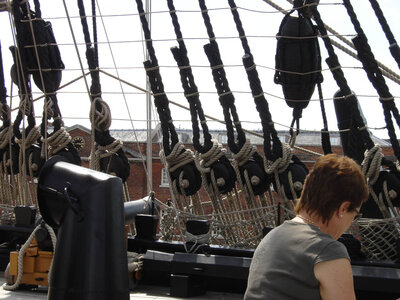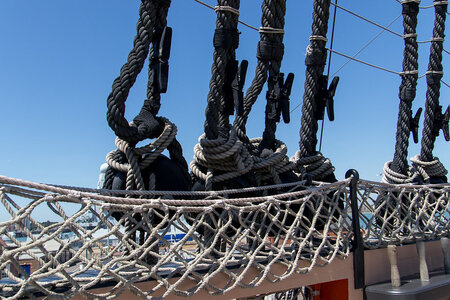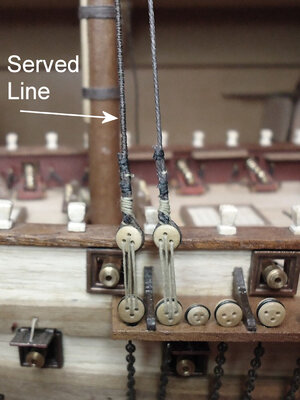We all know standing rigging is tarred (black) for protection and running rigging is left natural because it is handled. However, every model ship I see had both the shrouds and ratlines tarred (black). I can see the shrouds tarred as standing rigging but why the ratlines? The ratlines are constantly handled by the crew and I don’t think they want tar on their hands and feet. In fact, the ship would be a mess in short order with tar transferred to all the running rigging and the ship’s deck. I have been known to miss the point from time to time (just ask my wife) so if someone could set me straight I would appreciate it. Should ratlines be left natural?
-
LUCZORAMA SHIPWRECK SCAVENGER HUNT GIVEAWAY. 4 Weeks of Fun • 1 Legendary Prize ((OcCre’s Fram Ship)) • Global Crew Welcome!
**VIEW THREAD HERE**
You are using an out of date browser. It may not display this or other websites correctly.
You should upgrade or use an alternative browser.
You should upgrade or use an alternative browser.
They should be black in my opinion. Guess its a personal choice as there are ship models done both ways.
.
.
Just looking at photos of USS Constitution, it appears the ratlines are black on that ship.
Perhaps it varied from ship to ship.
.
Perhaps it varied from ship to ship.
.
No doubt. This depended on ship commanders.
The Endeavour replica ship has black ratlines. Then again there are multiple other ships that leave them natural.
.
.
A compromise: do the ratlines in dark brown thread. It will look almost as pleasing as black and could represent some alternative preservative.We all know standing rigging is tarred (black) for protection and running rigging is left natural because it is handled. However, every model ship I see had both the shrouds and ratlines tarred (black). I can see the shrouds tarred as standing rigging but why the ratlines? The ratlines are constantly handled by the crew and I don’t think they want tar on their hands and feet. In fact, the ship would be a mess in short order with tar transferred to all the running rigging and the ship’s deck. I have been known to miss the point from time to time (just ask my wife) so if someone could set me straight I would appreciate it. Should ratlines be left natural?
Tudor creosote? Bark boiled in vinegar with eye of newt?
Well, what I have done in the past was to take acrylic black (water-based) paint and dilute it just a little (maybe 50/50) and I put some paint-water solution in the palm of my hand and just 'ran' the cotton line through this and let it dry. I know this is not a 'purist' way of doing things, (and a little messy) but it did get me out of a situation one time. The only problem is that the paint can be too dry and not 'soak' into the cotton line. One time, I had a little bit of dried paint that did not soak into the cotton line and it tried to flake off. I redid it. I think the main thing was to make sure the paint was wet enough to soak into the thread.
it is my understanding that the shrouds and ratlines are all black.
it is my understanding that the shrouds and ratlines are all black.
- Joined
- Feb 15, 2019
- Messages
- 348
- Points
- 168

The Royal Navy used only the highest quality Stockholm Tar. They had a trade deal which gave them the monopoly on it. The colour varied depending on the tree, where it was grown as well as the production process, from a pale golden to black. So essentially there is no right or wrong regarding the colour. Standing rigging would be heavily coated and as a result probably darker. Running rigging was natural hemp. Ratlines would be tarred but less than the shrouds so the colour would depend on which barrel was opened!
- Joined
- Oct 9, 2020
- Messages
- 2,076
- Points
- 488

Now that's interesting. I always thought you had to serve all the shrouds. boy did i waste a lot of time lol
I think part of the discussion needs to redefine what is meant by “tar” on historical ships. Tar can mean everything from thick molasses stuff to turpentine like stuff in consistency. If we accept the premise that natural fiber line can last longer in a marine environment if its painted or impregnated with tar, then we need to understand what was actually used. What we often think of as “Tar“ can and often should be cut with turpentine or linseed oil or both, this allows it to flow better and penetrate the fibers of a rope. Full strength unadulterated pine tar has the consistency of molasses and appears black and is very gloppy. Repeated applications of this thick tar will eventually produce a thick black opaque coating and this is why shrouds and standing rigging is black, they have many coats of tar applied to them eventually leading to a hard shell of tar which keeps the water out.
I think a very thin consistency pine tar was painted or rubbed on all but a very few lines including ratlines. Also I have read (don’t remember where now) that pine tar was already in the rope when it arrived at the ship, having been applied at the ropewalk in a thinned solution or rubbed on with a rag to produce a coating that would penetrate the fibers and add to the lines longevity. But I don’t think it would have been applied in thick enough or repeated coatings sufficient to make the ratlines black.
So, think of “pine tar” as thick or thin. Thick stuff on standing rigging...thin stuff on running rigging including ratlines. The thin stuff would not turn the lines dark like the layers applied to the standing shrouds. Maybe it makes more sense to think of ratlines as “oiled” rather than “tarred.”
I think a very thin consistency pine tar was painted or rubbed on all but a very few lines including ratlines. Also I have read (don’t remember where now) that pine tar was already in the rope when it arrived at the ship, having been applied at the ropewalk in a thinned solution or rubbed on with a rag to produce a coating that would penetrate the fibers and add to the lines longevity. But I don’t think it would have been applied in thick enough or repeated coatings sufficient to make the ratlines black.
So, think of “pine tar” as thick or thin. Thick stuff on standing rigging...thin stuff on running rigging including ratlines. The thin stuff would not turn the lines dark like the layers applied to the standing shrouds. Maybe it makes more sense to think of ratlines as “oiled” rather than “tarred.”
Last edited:
Thanks for a well researched and interesting bit of information.








